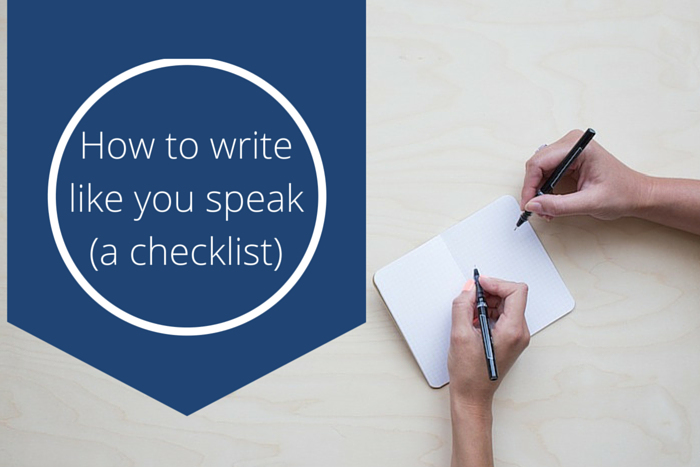I’m sure you’ve heard this before: write like you speak, especially online, where copy should conversational.
But putting that little gem into practice isn’t as easy as it sounds. What does “write like you speak” actually mean? And how can you tell if you’re hitting the mark?
I believe your voice shines through when you’re feeling relaxed and confident, and when you let yourself have a little fun. To get to that point, we all need to read a lot, write a lot, and get feedback from time to time. It’s a simple enough strategy, but it takes time and commitment.
But there are indeed some shortcuts and pointers to consider. I created this checklist on “how to write like you speak” to help you navigate the world of conversational copy. (Make sure you read to the end, because there are a few don’t-dos in there too.)

1. One reader at a time.
Imagine you’re writing to a single person. Reading is an intimate experience, like a conversation with a friend—not a speech in an auditorium. (Start by using the second-person “you.”)
2. Use contractions.
“I’ve” instead of “I have.” “You’re” instead of “you are.”
3. Loosen up.
Avoid formal words and phrases you’d never use in conversation, like “in addition,” or “furthermore.”
4. Vary your sentence length.
This creates rhythm. Experiment with repetition and using similar patterns of words for emphasis.
5. Use sentence fragments.
Include the occasional incomplete sentence, just do it intentionally. Despite what you were taught in school.
6. Be as outrageous as you are in real life.
If you are silly or neurotic or have an obscene love of puns, let ‘er rip in your writing. Seriously.
[Tweet “Loosen up, shorten up and walk away. A checklist for writing like you speak:”]
7. Put your paragraphs on a diet.
Keep them small (especially if you are writing for the web), and include some single-sentence paragraphs for ultimate impact and flow.
Try it.
8. Walk away.
Take a break between writing and editing. Long enough to forget exactly what you’ve written (or at least how you’ve written it).
9. Trim the tree.
While revising, remove extra or repetitive words. Look out for the word “that,” which can often be cut, and extra verbs that sneak into your sentences and make them flabby.
But not exactly as you speak…
10. Uhh…
Use verbal tics like “like” or “um” sparingly. They can add a spark of personality or playfulness, but they’re much more noticeable in print then they are in conversation.
11. Kill the clichés.
This includes idioms like “cat got your tongue?” or “when the rubber hits the road” and any other overused phrases people have heard a bazillion times. (But don’t stress—we all fall back on them sometimes.)
12. Remember nothing matters without clarity.
Make sure what you’ve written is clear. When we speak we have other tools to help us ensure we’re understood: inflection, or facial expression, for example. If the reader doesn’t understand us, we can try again. Not so in writing. It’s better to be plain than overly chatty in a way that confuses people.
[Tweet “Confuse your reader, lose your reader. #copywriting #clarity”]
13. Add details.
Take the time to use concrete details, paint a scene and tell a story. If you’re normally direct in conversation, this will take some practice.
For example, saying you know your reader is busy isn’t as powerful as describing what it looks and feels like to be busy: juggling client appointment with childcare, forgetting to eat lunch until 3 p.m., and running out of time to shower. You’re unlikely to say that in conversation with a friend, but in writing it can really help the reader connect.
14. Talk to yourself.
Always read your writing out loud before hitting publish. Where you stumble, your reader will stumble too. Whenever you feel compelled to simplify or adjust, also make that change on the page.
15. Read on, solider.
Like I said in the beginning, to be a great writer, you must first become an active reader. Look for examples of clear, compelling voice, and figure out what makes them sing. Re-read your favourite books. Write down your favourite sentences. Then, read some more.
![]()
The next time you write a new blog post or a page of copy, consider revisiting this list to see what you can check off. You could even bookmark this page as a reference.
And let me know in the comments: which of these tips would you like to put to use right away?
Get your writing on this weekend!
Whether you’re working on your website copy, blog posts, ebooks or other small business projects, you’re invited to set aside three days to write with a group of brilliant folks from around the world as part of my second Virtual Writing Retreat for Entrepreneurs. It’s a great way to kick off your year of epic content creation! The retreat is just around the corner now, but there’s still time to register.
Get the details and sign up right here (it’s free!).
Wishing you a wonderful year of writing!
xo,

Great checklist Nicole. It’s clear you’re already a pro at this! I need to work on #14!
I’m always learning too! #14 is a great one. I hope it helps!
#8- Walk Away…. so important! (And one I need to work on more myself.) A day’s time between writing and editing can make all of the difference, especially when you are emotionally invested in the words you are writing.
I also like to use the Dragon Dictation app on my phone to record my “inner” dialogue. I pretend like I am drinking coffee with a friend, explaining what I do. It really helps to listen back and see how I really talk… and then translate that conversational tone into more authentic copy.
Great post, Nicole! 🙂
That’s a great suggestion, Maisie. I’ve suggested that to people before so I’m glad to hear it works for you!
Yes, walking away is important but it can be so hard when we get busy!
Great tips! Thanks for sharing. Some of these come naturally, but I definitely forget to walk away sometimes, especially if I’m in a rush to get something out.
Totally, so do I. 🙂 Thanks for reading Tamara!
Excellent advice, and the witty headings in that gorgeous font are an added bonus. I already posted this week but I’ll use your checklist next time!
Awesome, thanks Ani! I love that font too.
i hope this arouses my interest to write more